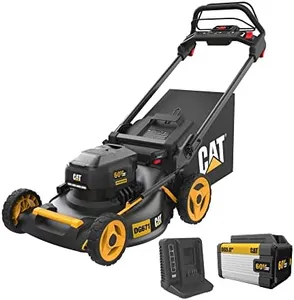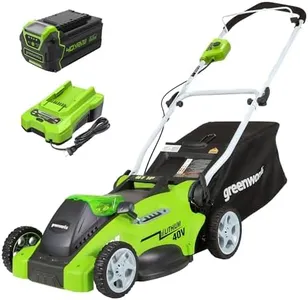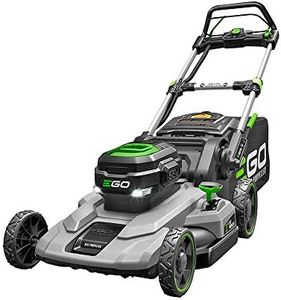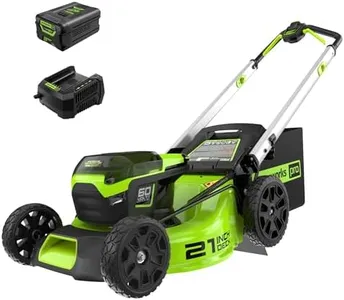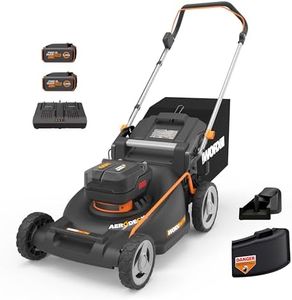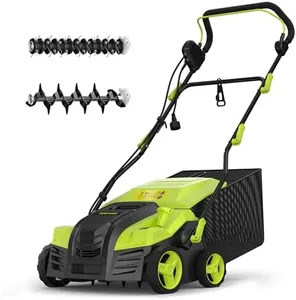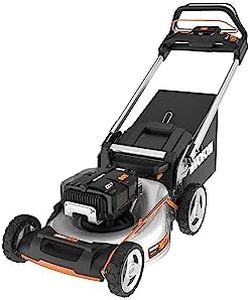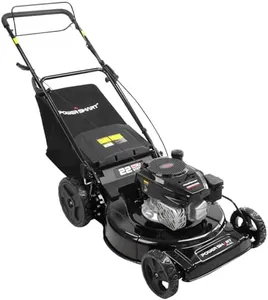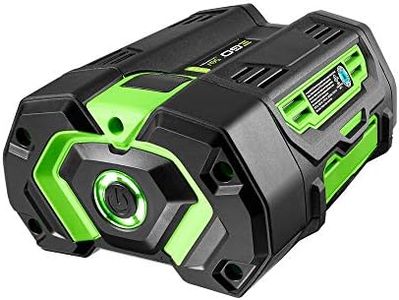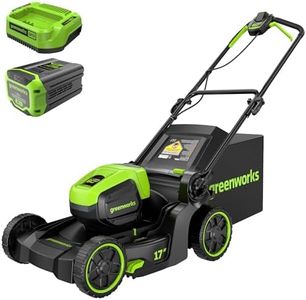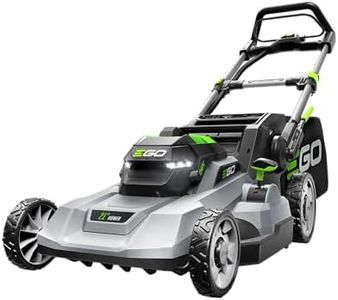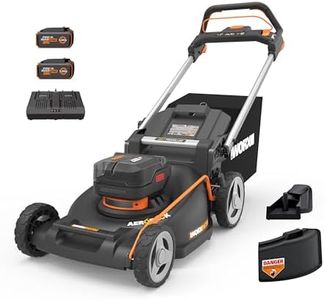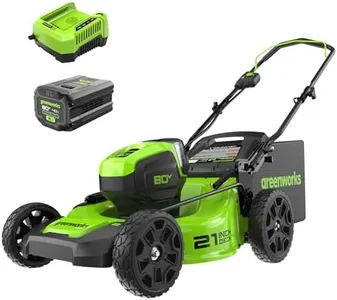10 Best Battery Lawn Mower 2025 in the United States
Our technology thoroughly searches through the online shopping world, reviewing hundreds of sites. We then process and analyze this information, updating in real-time to bring you the latest top-rated products. This way, you always get the best and most current options available.

Our Top Picks
Winner
Greenworks 40V 16" Cordless (Push) Lawn Mower (75+ Compatible Tools), 4.0Ah Battery and Charger Included
The Greenworks 40V 16" Cordless (Push) Lawn Mower is an efficient tool for maintaining small to medium-sized yards, up to half an acre. It boasts a 40V battery that provides up to 45 minutes of runtime on a full charge, though the charging time is relatively long at 120 minutes. The 16-inch cutting width is suitable for maneuvering through tighter spaces, making it ideal for compact lawns.
The mower is lightweight at 37.5 pounds, which, combined with the push-button start, enhances its ease of use. Additionally, the 5-position height adjustment ranging from 1-1/4" to 3-3/8" allows for flexibility in achieving the desired grass length. Users can choose between mulching and rear bagging, catering to different grass management preferences.
As a battery-powered device, it is virtually maintenance-free, eliminating the need for gas or oil and reducing emissions, which is a plus for eco-conscious users. However, users should be mindful that the smaller cutting width and longer charging time may require more frequent stops and planning, particularly for larger yards. The inclusion of a 4.0Ah battery and charger, along with a 3-year warranty for both the tool and battery, adds value to the purchase. This mower is best suited for those who prioritize ease of use, environmental friendliness, and have smaller to medium-sized lawns to maintain.
Customer Highlights
A summary of real customer reviews to highlight what shoppers are saying!EGO POWER+ Electric Lawn Mower, Self-Propelled Cordless, Includes 56V 7.5Ah Battery and Rapid Charger - LM2102SP
The EGO Power+ LM2102SP is a solid choice for those in the market for a battery-powered lawn mower, particularly for homeowners with medium-sized lawns. With a cutting width of 21 inches, it efficiently covers ground, and the 7.5Ah battery provides up to 60 minutes of runtime, which should be ample for most yards. One of its standout features is the adjustable self-propel speed, allowing users to choose a pace that suits them, from 0.9 MPH to 3.1 MPH. This flexibility can make mowing more comfortable, especially for those who might find traditional mowers hard to manage.
The mower also offers a 3-in-1 function, which includes mulching, bagging, and side discharge, making it versatile for different grass management preferences. The quick push-button start and bright LED headlights are convenient touches that enhance usability, especially for early morning or late evening mowing sessions. The weather-resistant construction and compact foldability for storage are additional benefits that many users appreciate.
There are some drawbacks to consider. While the 60-minute charge time is impressive, if your lawn requires more than an hour of mowing, you may need a backup battery, as the mower can’t be used while charging. Additionally, the lightweight design may not appeal to those who prefer a heftier mower that can handle tough terrain. Also, the height adjustment mechanism is one-handed, which is great, but some users might find it less intuitive if they’re used to traditional methods.
EGO POWER+ Electric Lawn Mower, Self-Propelled Cordless with Select Cut and Touch Drive, Includes 56V 7.5Ah Battery, Rapid Charger, & Extra 5.0Ah Battery – LM2135SP Extra Battery Bundle
The EGO POWER+ Electric Lawn Mower is a robust option for those seeking a battery-powered lawn mower with versatility and ease of use. Powered by a 56V 7.5Ah battery, with an additional 5.0Ah battery included, it offers ample power and up to 60 minutes of runtime on a single charge. This is suitable for medium to large yards, especially with the additional battery to extend mowing time. The rapid 60-minute recharge time ensures minimal downtime between uses.
With a cutting width of 21 inches, it covers a good amount of ground efficiently, reducing the number of passes needed to mow the lawn. The mower's eight cutting height positions (ranging from 1 to 4 inches) offer flexibility to accommodate different grass lengths and preferences. Its Select Cut multi-blade system allows for customizable cutting performance, suitable for various lawn conditions.
The Touch Drive self-propelled technology makes it user-friendly, providing better control and reducing physical strain during operation. Weighing in at an average range for battery mowers, it balances maneuverability with durability. Grass management options include mulching, bagging, and side discharge, making it a versatile choice for different lawn care needs. A 5-year tool warranty and a 3-year battery warranty add assurance of the product's reliability. The mower's price point may be higher compared to other models, and the additional battery might ship separately, potentially causing inconvenience. This mower is ideal for homeowners looking for a powerful, flexible, and user-friendly lawn care solution without the hassle of gas-powered engines.
Customer Highlights
A summary of real customer reviews to highlight what shoppers are saying!Buying Guide for the Best Battery Lawn Mower
Choosing the right battery lawn mower can make your lawn care routine much easier and more efficient. Battery lawn mowers are known for being eco-friendly, quieter, and easier to maintain compared to their gas-powered counterparts. When selecting a battery lawn mower, it's important to consider several key specifications to ensure you get the best fit for your needs. Understanding these specs will help you make an informed decision and find a mower that suits your lawn size, grass type, and personal preferences.FAQ
Most Popular Categories Right Now
